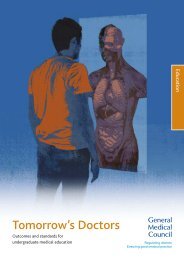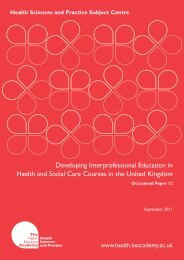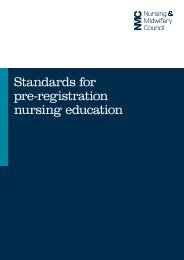(WHO) Patient Safety Curriculum Guide - CAIPE
(WHO) Patient Safety Curriculum Guide - CAIPE
(WHO) Patient Safety Curriculum Guide - CAIPE
Create successful ePaper yourself
Turn your PDF publications into a flip-book with our unique Google optimized e-Paper software.
once students understand how health care<br />
is delivered and they are more familiar with<br />
the workplace environment.<br />
ñ Students will be more likely to change practices<br />
if they have the opportunity to use what they<br />
have learnt shortly after it is covered in the<br />
curriculum.<br />
When teaching a patient safety topic, there are<br />
advantages if the knowledge and performance<br />
requirements are covered together. A clear<br />
understanding of the scope of a problem in<br />
patient safety will provide motivation and insight<br />
when learning about performance requirements.<br />
Students are also less likely to feel demoralized<br />
about the risks facing patients from the healthcare<br />
system they will soon be a part of. If they<br />
explore solutions (applications) and learn practical<br />
strategies (performance elements) to make them<br />
safer providers of health care at the same time,<br />
they will be more positive. For logistical reasons,<br />
it may not be possible to cover the knowledge<br />
and performance requirements of a patient safety<br />
topic at the same time.<br />
If your curriculum is traditional, then knowledge<br />
and performance requirements of patient safety<br />
are best taught in later years when students have<br />
more knowledge of professional practice and<br />
exposure to patients and workplace skills’ training.<br />
The context for the knowledge and performance<br />
requirements should match the students’ ability<br />
to put into practice their new knowledge.<br />
Introductory patient safety knowledge can still be<br />
included in the early years in subjects such as<br />
public health, epidemiology, ethics, or other<br />
behavioural science-based subjects. Suitable topics<br />
for early introduction include: (i) what is patient<br />
safety?; and (ii) systems and complexity in health<br />
care. If your curriculum is integrated and students<br />
are taught clinical skills from the first year, then<br />
patient safety topics are best introduced early and<br />
vertically integrated throughout the entire course.<br />
This makes patient safety a constant theme and<br />
provides opportunities to reinforce and build<br />
upon earlier learning. Ideally, students should be<br />
exposed to patient safety education prior to and<br />
upon entering the workplace.<br />
When and where in the curriculum are<br />
particular subjects and topics taught<br />
that might lend themselves to inclusion<br />
of patient safety teaching?<br />
Any area of learning relevant to a particular<br />
profession can potentially house a patient safety<br />
topic if a sample case is part of the session and<br />
is relevant to that discipline. For example, a case<br />
involving a medication error in a child could be<br />
used as the starting point for teaching nurses<br />
about understanding and learning from errors<br />
while studying paediatrics. Similarly, during<br />
learning about managing patients after hip<br />
or knee replacements, a physiotherapy student<br />
could learn about the topic “patient safety<br />
and invasive procedures”. Many areas could house<br />
the topic of “understanding and learning from<br />
errors” if the case was relevant to that particular<br />
discipline. The learning, however, is generic<br />
and relevant for all disciplines and all students.<br />
Box A.6.3 sets out opportunities for examining<br />
the integration of patient safety topics.<br />
Box A.6.3. Integration of patient safety topics<br />
<strong>Patient</strong> safety topic<br />
Minimizing infection through<br />
improved infection control<br />
Improving medication safety<br />
Being an effective team player<br />
What is patient safety?<br />
Subjects that could house patient safety topics<br />
Microbiology<br />
Procedural skills’ training<br />
Infectious diseases<br />
Clinical placements<br />
Pharmacology<br />
Therapeutics<br />
Orientation programmes<br />
Communication skills’ training (interprofessional)<br />
Emergency disaster training<br />
Ethics<br />
Introduction to the clinical environment<br />
Clinical and procedural skills’ training<br />
43 Part A 6. How to integrate patient safety learning into your curriculum













